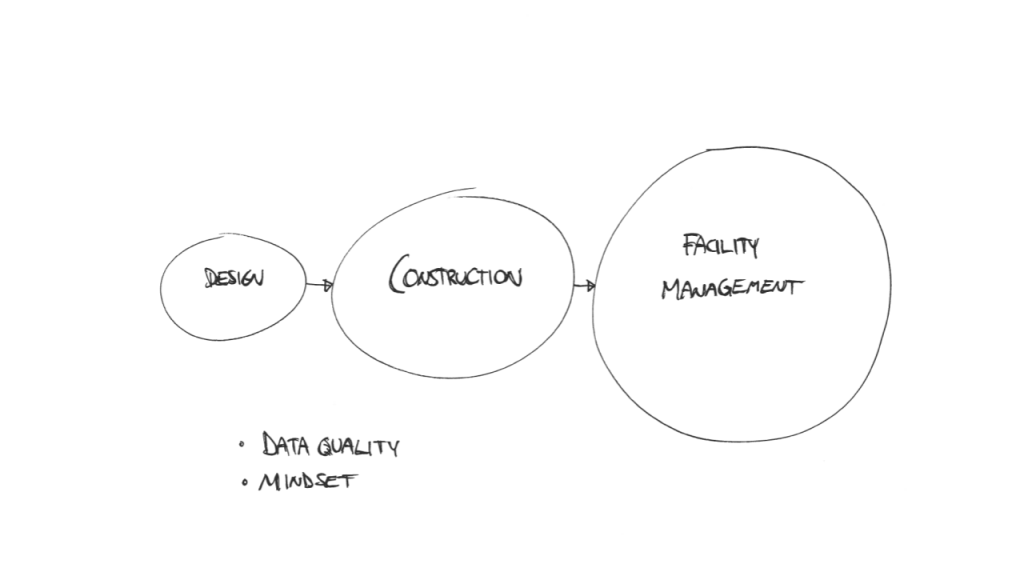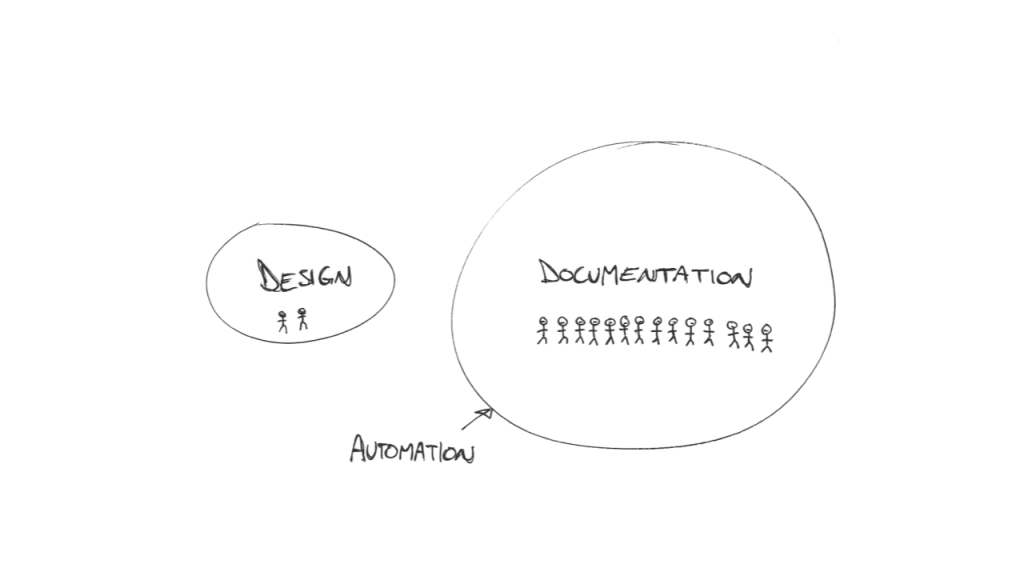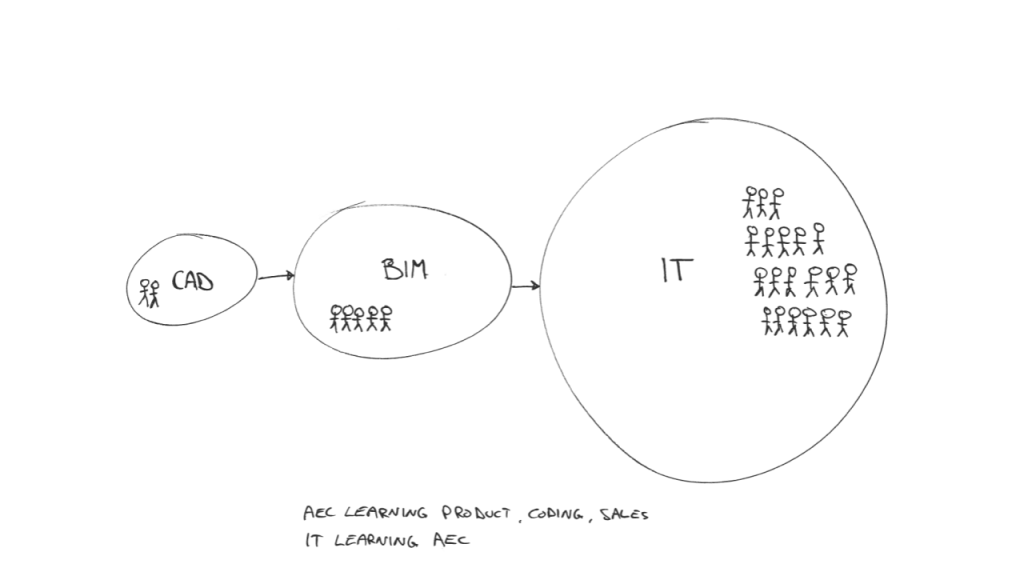This text is not going to win a Nobel prize. It’s not rocket science. It’s the collected reflections of someone who started off as a BIM Manager, became a IT product and consultancy founder and now is trying to help make construction and real estate more effective through digitization.
The productivity of AEC is going down. Other industries’ productivity arrows are pointed up, but ours is not. After 20 years of BIM one would think it would be different. But it’s not. There are probably thousands of reasons for that, and I would never imagine knowing a fraction of them. But I think one of the reasons, however small it is, has to do with an unrealized potential in BIM.
Back in the day when we were getting started with BIM we used to joke about how stupid it was to model a comprehensive, complete and detailed 3D database and then print it flat on paper. Little did I know back then that we would still be doing that in 2023. Some local AEC industries and projects have started implementing data driven construction and real estate based on data created by design teams, but the examples are still few.
Other industries are implementing AI at scale. The AEC industry cant. These are my thoughts on why not and what we can do about it, along with a few good signs that we are on the right path.
Information Value

When an architect models a door in a 3D design software, all the choices that dictate what they do and how they do it are shaped by their end goal; what their delivery is. If it’s important that the plan drawings have a certain ‘look’, the plan representation will be worked on. If the door schema and schedule is important, great care will be taken in 2D representation, dimensions and materials. If 3D rendering is critical, render appearance will dictate what we choose to do.
When the traditionally printed information, like plans, elevations, schemas and renders, disappear from our work, and are replaced by elements with properties in databases, we need to learn how to produce, validate, represent and communicate the same information as data. The information that printed media contained needs to be carried as digital data.
This transition is happening now. It is happening because contractors and real estate owners are trying to digitize their operations. They can’t until they start receiving digital information.
In my view, there are two main changes that we need to make to go peacefully through this transition.
Firstly, we need to create quality data much faster and more consistently than today. Manually punching text parameters in Revit simply does not make the cut. Endless scripts in Excel, Dynamo and Grasshopper are also not going to help much outside of the projects where they were created. There are also no shortage of addins and desktop applications that try to improve the experience, effectiveness and quality of data outputs from BIM, but most of them are lipstick on a pig: trying to make Revit do something that Revit was never built to do; high quality consistent data outputs.
We need completely new ways of programmatically creating, validating and distributing data, for it to have the quality that is needed for the receivers to enjoy the information they contain.
Secondly, as mentioned at the beginning of this chapter, people who create information need to know what the purpose of the information they create is. An architect modeling a door needs to know exactly what data is important about the door for downstream usage. We need to understand the end goal of the data we create for us to create good and relevant data.
The only way information becomes valuable downstream, is if it contains what people need and is of exceptional quality.
But there is light! On the reconstruction of the Viking Age Museum in Oslo, the entire project team is producing the first digital delivery in history to fulfil the building owner’s data requirements for digital construction and real estate management. The owner has configured automatic model publishing and accurate data validation together with the contractor, and the design team is streaming validation results into their design software for instant fix.
This process is helping the contractors and owners build trust in data, and it is helping design teams understand what data is important.
Information Management

I call it the Boulevard of Broken Dreams. If you walk around a normal architecture firm you will see some architects designing things and you will see many who are not. What are the non-designing architects doing? They are documenting. They are modeling BIM, checking interferences, coordinating with engineers, classifying elements, and adding metadata. They are tagging, texting, hatching and dimensioning drawings. No architect starts in architecture school to do this, but it is what a shockingly high amount of architects end up doing. And it’s the same with engineers.
Is that a good use of human resources? Shouldn’t humans use their creativity on designing quality space and sustainable structures, instead of creating construction documentation? It just seems like such a bad use of human capability.
Design Automation has become a thing. I have seen and used the hashtag countless times on Linkedin. But what happened to Documentation Automation? And I’m not talking about automatic dimensioning and tagging in Revit. We need to aim much higher.
I believe that we need to reduce the amount of time people spend on documentation, and increase our efforts on design. I believe that workflows connected with classification, quantification, communication, dimensioning, tagging, should all be fully automated.
Imagine how wonderful it would be if designers could do whatever they want in their design software, and a system took care of all documentation? An architect could model a door as a window, and the tool would classify it as a door based on what it looks like, how it behaves and which data it contains, possibly based on previous data. If it looks like a duck and quacks like a duck, it’s most likely a duck. That would be an easy sell for architects.
With the disappearance of drawings to the benefit of data we have a golden opportunity to innovate in this space, and a few projects have started venturing in this direction.
On the New Government Quarter project in Oslo, the design team has fully automated all model exports and imports. They have also automated model standardization and metadata creation. This means that no human beings are exporting data anymore, and everyone in the project knows exactly where to look for information and that what they are seeing is the latest version.
Information Technology

Stating that the future of BIM is Information makers you reflect: isn’t there already an entire industry dedicated to information? Isn’t it called Information Technology? The IT industry?
The past 10 years a wave of AEC professionals have started coding. For many of us it started with simple visual scripting in BIM and CAD. For a few it continued with textual programming, and went on with databases, web technologies, AI and ML. I have always maintained that the most important change visual scripting brought was the impact of the coding architects and engineers.
What also happened at the same time as these architects and engineers starting programming, was that they found and connected with an entire ecosystem of IT professionals. That’s how many of them learnt about databases, web technologies, AI and ML.
The two industries are coming closer, and that is exactly what needs to happen for the AEC industry to innovate. AEC professionals learn about proper IT, and IT finally learns about AEC.
But we are learning other things that are important too from IT. We are learning about scalability. We are learning that the value of a digital tool or process is close to insignificant if it is only used by one person, on one project or in one country. Building good IT is expensive; is there a proper ROI analysis behind the effort, or are we just “coding away”?
At the same time, we often need to “code away” without asking for permission to solve big project deliverables and not least create good ideas for future applications. Building things that don’t scale is a popular term in IT, but it shouldn’t be confused with building things that other people hate.
What then can we do to get better at bringing proper IT into AEC?
Focus
The biggest difference between coding “for fun” on a project and working in an environment where the quality of your product determines if your children eat, is focus. The parameter “do my children get food?” has that effect.
You also get focus when you and the other people working on a product are in the same legal entity and that the only people you answer to are your paying clients and investors.
Invest your own money
Building a product is a lifestyle, it’s not a job. It’s obsessive in nature, and you are never really off work because there is always someone using it. To get people to sign up for that, they should ideally have skin in the game. If they don’t, it’s just another job and your product will suck.
Get runway
One day, we are out of cash. That almost never happens in a building project, and when it does, it creates headlines. In IT it happens all the time. Having a deadline that is actually a deadline, is terrifying but very motivating. Especially when it’s your own money that ran out.
Sales and marketing
We say that a product has the right to live if you sign 10 contracts with people who are not your “friends or family”. With “friends and family” we mean people that you know in the industry. Developing products for your friends can be great in the beginning, but it will never scale because they have close to unlimited patience with your sucking UX. Strangers don’t.
People say that sales is the most difficult job in the world. I think so. And I think that is probably going to be the biggest challenge of non-product companies developing and scaling products. An engineering company simply does not have a clue how to sell and market an IT product. Architects are better, but most of the architects I met never really cared about information products, so there you go.
If you are not going to sell your product to other people, projects or companies, preferably in other countries, make sure that there is a ROI in your organization or that the idea can lead to something valuable. If not, it’s most likely a complete waste of your time and your client’s resources.
I think that AEC needs to increase investments in their own drastically growing startup community to see the emergence of new solid, scalable, user friendly, powerful and globally available information systems. There are so many dedicated former architects and engineers out there building new tools every day (and night), and spending your resources by supporting their passion is my best bet for a digital future for construction and real estate.


